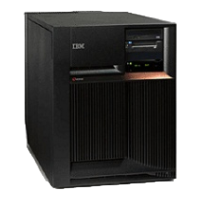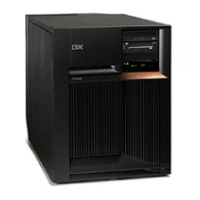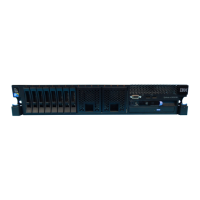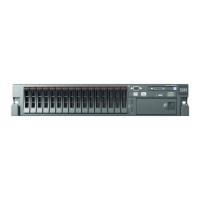v Yes: The book just reinserted is defective. Replace it. Return the system to its original
configuration. See Verify the repair.
This ends the procedure.
v No: Continue with the next step.
11.
Have all the books listed in step 4 (See page 386) been reinserted?
v Yes: The symptom has changed. Return the system to its original configuration. See Verify the
repair.
This ends the procedure.
v No: Go to step 8 (See page 386).
12.
Power off the system. See Power on/off the system and logical partitions. Then, examine the amber
logic-power LEDs of all installed processor subsystem DCAs.
13. Are all amber logic-power LEDs of all installed processor subsystem DCAs off?
v Yes: Continue with the next step.
v No: Replace the DCA that has the amber logic power LED that did not turn off. See symbolic FRU
“DCAPWR” on page 324.
14.
Replace one of the books in the following list, if present, one at a time and in the listed order with a
new book. See symbolic FRU “DCAPWR” on page 324.
a. DCA 1 at location M31
b. DCA 2 at location M32
c. DCA 3 at location M34
d. DCA 4 at location M35
e. DCA 5 at location M36
15.
Power on the system. See Power on/off the system and logical partitions.
16. Did the system stop with the same error code as recorded in step 1 (See page 386)?
v Yes: Continue with the next step.
v No: The book just replaced is defective. Return the system to its original configuration. See Verify
the repair.
This
ends the procedure.
17.
Power off the system. See Power on/off the system and logical partitions. Then, make sure all amber
logic-power LEDs of all installed processor subsystem DCAs are off.
18. Remove the new book that was just installed in step 14 (See page 387) and reinstall the original
book.
19. Have all the books listed in step 14 (See page 387) been replaced with new or original books?
v Yes: Continue with the next step.
v No: Go to step 14 (See page 387).
20.
Power off the system. See Power on/off the system and logical partitions. Then, examine the amber
logic-power LEDs of all installed processor subsystem DCAs.
21. Are all amber logic-power LEDs of all installed processor subsystem DCAs off?
v Yes: Continue with the next step.
v No: Replace the DCA that has the amber logic power LED that did not turn off. See symbolic FRU
“DCAPWR” on page 324.
22.
Attention: Before you remove or replace an MCM module, stop, read, and understand the Testing
MCMs and passthru modules for a short circuit procedure.
Attention: MCM modules have a limit of three plug cycles. Before replacing any of the MCMs in the
following list, call your next level of support.Record the original location on each MCM. Remove the
following MCM modules, if present. See the Models 870 and 890 - MCM module (processor) and
pass-through modules remove and replace procedure.
v MCM module 0 at location M21
Analyze hardware problems 387

